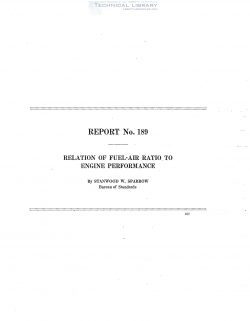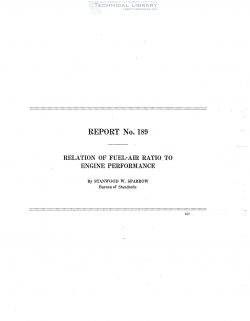naca-report-189

- Version
- 347 Downloads
- 1.32 MB File Size
- 1 File Count
- August 25, 2016 Create Date
- August 25, 2016 Last Updated
National Advisory Committee for Aeronautics, Report - Relation of Fuel Air Ratio to Engine Performance

This report was prepared for publication by the National Advisory Committee for Aero—
nautics and the tests upon which it is based were made at the Bureau of Standards between
October, 1919, and May, 1923. From these it is concluded that: (1) with gasoline as a fuel, maxi—
mum power is obtained with fuel-air mixtures of from 0.07 to 0.08 pounds of fuel per pound
of air; (2) maximum power is obtained with approximately the same ratio over the range of
air pressures and temperatures encountered in flight; {3) nearly minimum specific fuel consump—
tion is secured by decreasing the fuel content of the charge until the power is 95 per cent of its
maximum value.
Presumably this information is of most direct value to the carbureter engineer. A car-
bureter should supply the engine with a suitable mixture. Thisreport discusses what mixtures
have been found suitable for various engines. It also furnishes the engine designer with a
basis for estimating how much greater piston displacement an engine operating with a maxi—
mum economy mixture should have than one operating with a maximum power mixture in
order for both to be capable of the same power development.
Of the published information on the relation of fuel-air ratio to engine performance, little
has been derived directly from test-s of aviation engines- Nor have many tests been made at
low air pressures. and temperatures, conditions of major importance from an aviation standpoint.
Much of the information that does relate directly to aviation problems is contained in Technical
Reports Nos. 48, 49, and 108 of the National Advisory Committee for Aeronautics. The titles
and authors of these reports are given in the bibliography.
Measurements of engine performance with various fuel-air ratios have been obtained in the
course of tests of aviation engines in the altitude laboratory of the Bureau of Standards In
most instances these tests were not made primarily to investigate the efi'ect of changes :11 fuel-
air ratio, and hence the range of mixtures studied was sometimes rather narrow. In general
however, the information covers a wide range of fuel—airratios, air pressures, air temperatures,
engine speeds, and engine loads. Moreover, such data, have been obtained from tests of several
engine types. It is believed that an analysis of the above-mentioned data will contribute
materially to existing Uknowledge of the relation between fuel-air ratio and engine performance.
| File | Action |
|---|---|
| naca-report-189 Relation of Fuel Air Ratio to Engine Performance.pdf | Download |
Comment On This Post